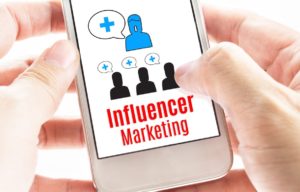
“People can break through the noise. People trust people. Influence is about relationships.“ — Ty Heath @tyrona
The COVID-19-induced lockdown shined a huge, glaring spotlight on influencer marketing, catapulting this already-proven tactic to new heights. Thanks to the millions of folks sheltering-in-place who suddenly had the time and inclination to exponentially increase their “screen time,” influencers reaped the perfect opportunity to engage the masses. While the in-person world took a hiatus, brands far and wide shifted marketing dollars into digital media and pinned their hopes on influencer marketing.
What IS influencer marketing?
Influencer marketing happens when companies partner with “influencers” to ramp up brand awareness or garner conversions from among a specific target audience.
Which begs the question, what’s an “influencer”?
“In order to understand influencer marketing, you need to understand influencers,” says Rochelle Bailis, VP of Marketing at Mediakix. “A social media influencer is someone who has built a loyal following through their online content creation.”
Consider the picture these statistics paint about influencer marketing.
- From $1.7 billion in 2016 to an estimated market size of $9.7 billion in 2020 to an expected reach of $13.8 billion in 2021.
The strategy is experiencing tremendous growth.
- Nine out of 10 brands are using some form of influencer marketing.
The business world is onboard.
· 56% of brands use the same influencers across different campaigns.
Relationships play a vital role in the success of influencer marketing.
And when it comes to the consumer side, Griffin Thomas, product marketing manager for Outbound, has compiled these stats.
- 52% of socially-engaged shoppers—those who follow influencers and converse with brands—purchase via social platforms versus only 35% of all consumers.
- 61% of the 18- to 34- demographic admits that influencers do influence their decision-making.
- 70% of internet users in the U.S. actively follow influencers.
The Challenges
As is true of most worthwhile endeavors, influencer marketing is not without its share of challenges. One culprit of less-than-the-hoped-for results rises from a lack of preparation. Either the plan isn’t put together thoughtfully, isn’t executed well, or misses the mark in being authentically aligned with the audience.
Understanding the different types of influencer marketing presents another critical challenge. Despite a common belief to the contrary, it’s not all about utilizing celebrities to promote your products. Yes, it’s true that in its earliest days—we’re talking centuries ago—when royalty promoted Wedgewood chinaware, celebrity influencers were the name of the game. But that was eons before social media’s explosion of popularity. Now, many brands look to—
- Macro influencers who tend to be bloggers, journalists, or executives with social media followings of 10,000 to 1,000,000, who garnered 5% to 25% engagement on their posts, often focused around high-level topic areas
- The micro-influencer whose social media reach, although smaller at an average of 500 to 10,000 followers per platform, generates a 25% to 50% engagement rate, indicating a relationship connection that is so important
- The term “nano influencer” typically refers to Instagram users with between 1,000 and 5,000 followers. Again, this smaller audience tends to translate into greater levels of connection that incorporate the guy/gal-next-door vibe.
What’s New in 2021
The marketing universe is ever-evolving, and that applies profoundly to the sphere inhabited by influencer marketing. Some of the key changes and trends noted in 2021 include—
- The rise of micro and nano influencers
Companies have been sold on the reach effectiveness of micro and nano influencers, realizing that a massive number of followers doesn’t always translate into a bigger splash for their brand. They understand that the quality of the connection matters more than the number of connections. Engagement rates trump follower stats.
- Authenticity over polish
Across the board, from the consistency of everyday life to the business world, authenticity’s stock spiked due to the pandemic—a positive in a sea of sorrow and confusion. While authenticity in advertising had been garnering more focus, COVID-19 and its ensuing challenges stripped away the remaining pretenses. In-the-moment and transparency-driven posts replaced the edited, polished, and perfectly manicured content formerly found in many influencers’ content. Many in the industry forecast that these reality-based messages are here to stay, which will likely bode well in the areas of trust-building and relationship-nurturing.
Every industry can benefit from engaging in influencer marketing. So, explore the options that fit your brand, your company’s mission, and your long-term and short-term goals. And get the show on the road.
That’s where ASJ Partners can help. We know the recruiting and staffing industry because that’s all we do. Our team of specialists excels at designing unique, customized, highly targeted marketing programs that will get your brand noticed. Contact us today to see how a partnership with ASJ can help your company reach new heights.




